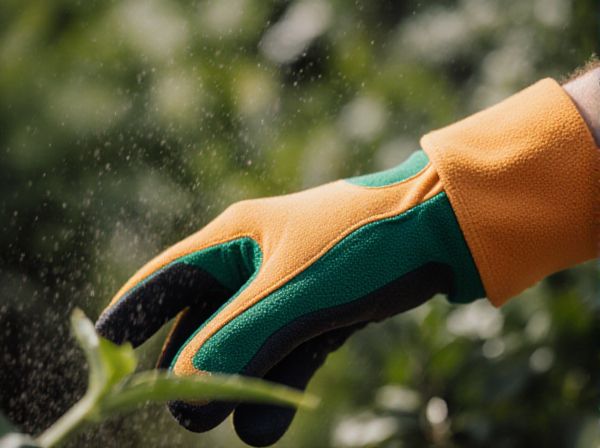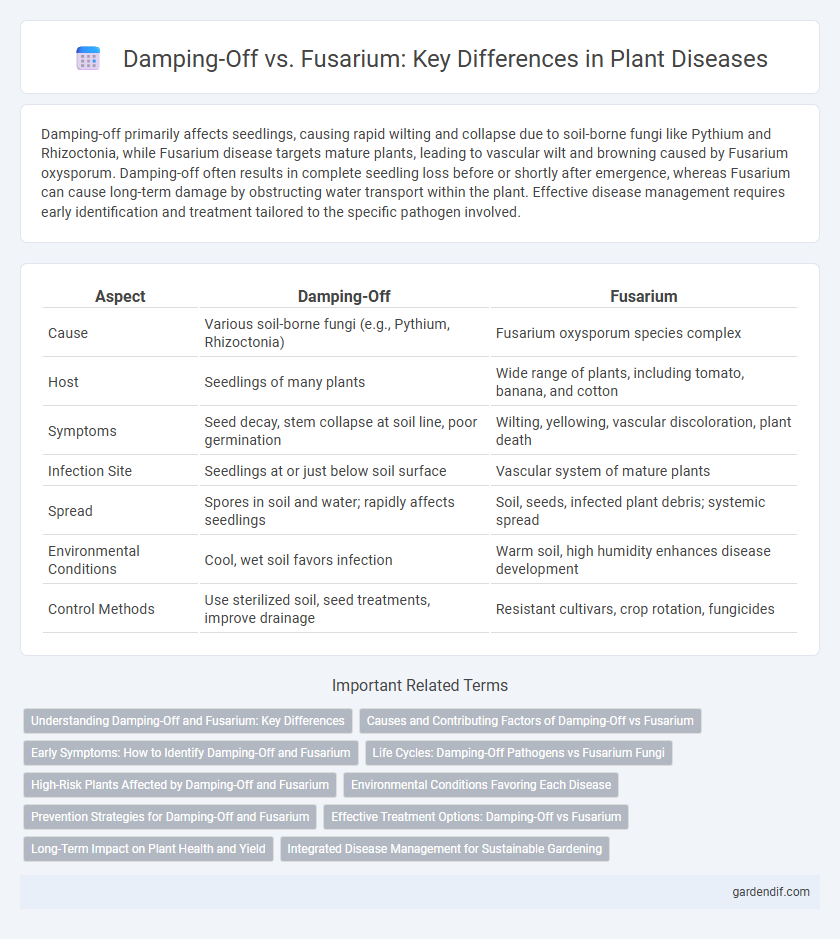
Damping-Off vs Fusarium Illustration
Damping-off primarily affects seedlings, causing rapid wilting and collapse due to soil-borne fungi like Pythium and Rhizoctonia, while Fusarium disease targets mature plants, leading to vascular wilt and browning caused by Fusarium oxysporum. Damping-off often results in complete seedling loss before or shortly after emergence, whereas Fusarium can cause long-term damage by obstructing water transport within the plant. Effective disease management requires early identification and treatment tailored to the specific pathogen involved.
Table of Comparison
| Aspect | Damping-Off | Fusarium |
|---|---|---|
| Cause | Various soil-borne fungi (e.g., Pythium, Rhizoctonia) | Fusarium oxysporum species complex |
| Host | Seedlings of many plants | Wide range of plants, including tomato, banana, and cotton |
| Symptoms | Seed decay, stem collapse at soil line, poor germination | Wilting, yellowing, vascular discoloration, plant death |
| Infection Site | Seedlings at or just below soil surface | Vascular system of mature plants |
| Spread | Spores in soil and water; rapidly affects seedlings | Soil, seeds, infected plant debris; systemic spread |
| Environmental Conditions | Cool, wet soil favors infection | Warm soil, high humidity enhances disease development |
| Control Methods | Use sterilized soil, seed treatments, improve drainage | Resistant cultivars, crop rotation, fungicides |
Understanding Damping-Off and Fusarium: Key Differences
Damping-Off is a soil-borne disease caused primarily by fungi such as Pythium and Rhizoctonia, resulting in the rapid wilting and collapse of seedlings, whereas Fusarium is caused by Fusarium oxysporum, leading to vascular wilt and root rot in mature plants. Damping-Off affects young seedlings at the soil line with symptoms like stem lesions and soft rot, while Fusarium attacks the vascular system, causing yellowing, wilting, and stunted growth over time. Effective management of Damping-Off involves proper soil drainage and seed treatment, whereas controlling Fusarium requires crop rotation and resistant cultivars to limit soil-borne inoculum.
Causes and Contributing Factors of Damping-Off vs Fusarium
Damping-off is primarily caused by soil-borne fungi such as Pythium, Rhizoctonia, and Fusarium species, thriving in overly wet, poorly drained soil conditions that promote seedling rot. Fusarium, specifically Fusarium oxysporum, results from fungal invasion in the vascular system, often exacerbated by warm soil temperatures and stressed plants. Poor sanitation, high humidity, and continuous cropping without rotation enhance the survival and spread of both pathogens, but Fusarium particularly benefits from root injuries and nutrient imbalances.
Early Symptoms: How to Identify Damping-Off and Fusarium
Damping-off typically presents with seedling collapse, water-soaked lesions at the soil line, and inhibited root development within days of germination. Fusarium symptoms emerge as yellowing leaves, wilting, and vascular discoloration in stems, often leading to stunted growth over several weeks. Early detection of damping-off focuses on soil conditions and seedling base rot, while Fusarium identification relies on observing internal stem browning and gradual plant decline.
Life Cycles: Damping-Off Pathogens vs Fusarium Fungi
Damping-off pathogens primarily consist of soil-borne fungi like Pythium, Rhizoctonia, and Fusarium species that thrive in moist, cool environments, producing spores that infect seeds and seedlings during germination. Fusarium fungi exhibit a more complex life cycle involving both sexual and asexual reproduction, producing chlamydospores, macroconidia, and microconidia that survive in soil and plant debris for extended periods, facilitating long-term persistence and infection. The rapid infection cycle of damping-off pathogens contrasts with the prolonged survival strategy of Fusarium, contributing to their differing impacts on plant health and disease management strategies.
High-Risk Plants Affected by Damping-Off and Fusarium
High-risk plants affected by Damping-Off include seedlings of vegetables like lettuce, tomatoes, and cucumbers, which are highly susceptible to soil-borne pathogens causing stem and root rot. Fusarium targets a broader range of crops such as bananas, tomatoes, and cotton, often leading to vascular wilt and significant yield losses. Both diseases thrive in warm, moist conditions, making young plants particularly vulnerable to infection and requiring vigilant disease management strategies.
Environmental Conditions Favoring Each Disease
Damping-Off thrives in cool, wet, and poorly drained soils that promote seedling decay and root rot during early plant growth stages. Fusarium disease favors warm soil temperatures, dry conditions, and high soil pH, encouraging fungal colonization in vascular tissues and causing wilting symptoms. Understanding these distinct environmental conditions helps optimize disease management and reduce crop losses.
Prevention Strategies for Damping-Off and Fusarium
Implement rigorous seed sterilization and ensure well-drained soil to prevent damping-off by reducing excess moisture that favors pathogen development. Crop rotation and resistant cultivars effectively mitigate Fusarium infection by disrupting the pathogen's lifecycle and limiting host susceptibility. Integrating biological control agents and maintaining proper field sanitation further enhances disease management for both damping-off and Fusarium wilt.
Effective Treatment Options: Damping-Off vs Fusarium
Effective treatment options for damping-off primarily involve improving soil drainage, applying fungicides such as thiophanate-methyl or metalaxyl, and maintaining proper seed spacing to reduce moisture buildup. Fusarium wilt requires the use of resistant plant varieties, soil solarization, and fungicides like fludioxonil or azoxystrobin to manage the pathogen effectively. Integrated management combining cultural practices and chemical treatments enhances control of both damping-off and Fusarium diseases.
Long-Term Impact on Plant Health and Yield
Damping-Off primarily affects seedlings, causing rapid mortality and reducing stand establishment, which can lead to significant initial yield losses but typically does not have long-term impacts on mature plants. Fusarium, particularly Fusarium wilt, causes chronic vascular damage leading to reduced water and nutrient transport, resulting in sustained declines in plant vigor, stunted growth, and progressively lower yields over multiple growing seasons. Effective management of Fusarium is critical for maintaining long-term crop health and productivity, whereas controlling Damping-Off focuses on improving seedling survival and early-stage plant population density.
Integrated Disease Management for Sustainable Gardening
Integrated disease management for damping-off and Fusarium combines cultural practices, resistant varieties, and biological controls to reduce soilborne pathogen impact. Crop rotation, soil solarization, and proper seed treatment minimize pathogen load, while beneficial microbes like Trichoderma spp. enhance plant defense. Consistent monitoring and maintaining optimal soil conditions ensure sustainable gardening by limiting disease incidence and promoting plant health.
Damping-Off vs Fusarium Infographic

 gardendif.com
gardendif.com